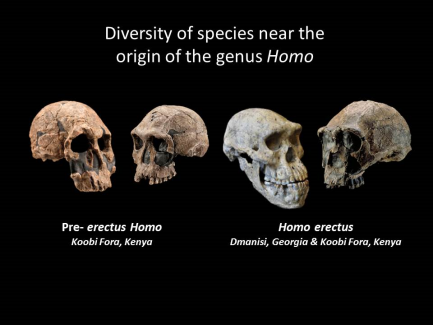
Kenyan fossil casts (Chip Clark, Smithsonian Human Origins Program); Dmanisi Skull 5 (Guram Bumbiashvili, Georgian National Museum)
These fossil skulls, representing pre-erectus Homo and Homo erectus, exhibit diverse traits and indicate that the early diversification of the human genus was a period of morphological experimentation. In July 2014, Smithsonian paleoanthropologist Richard Potts and a team of researchers analyzed new scientific data and concluded that the ability of early humans to adjust to changing conditions ultimately enabled the earliest species of Homo to vary, survive and begin spreading from Africa to Eurasia 1.85 million years ago.
Kenyan fossil casts (Chip Clark, Smithsonian Human Origins Program); Dmanisi Skull 5 (Guram Bumbiashvili, Georgian National Museum)


